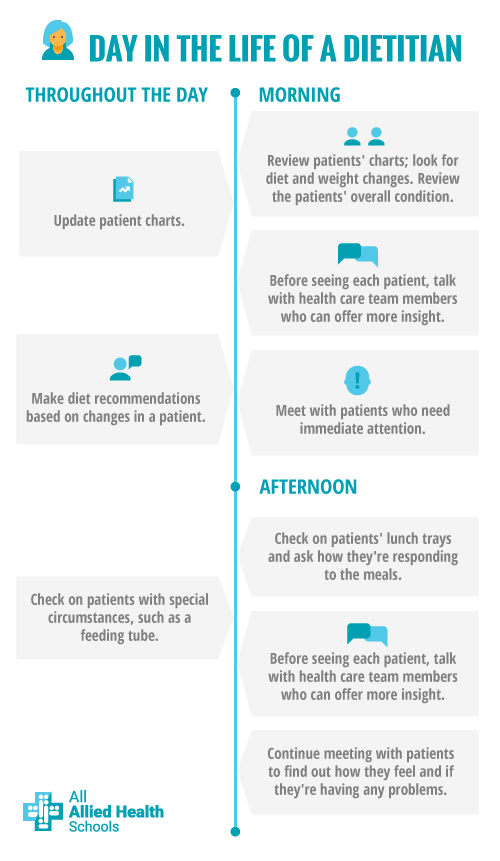
Dietitian Job and Degree Details
Educational Requirements
Dietitians are experts in nutrition science. You’ll need a bachelor’s degree in nutrition, or a closely related field, to get started in your career.
Your best bet is to earn a degree from a program accredited by the Academy of Nutrition and Dietetics. Some of these programs are combined bachelor’s/master’s tracks, which provide both classroom and on-the-job training.
What Dietitian Coursework Will Cover
Nutrition Degrees
A nutrition degree is your first step toward becoming a dietitian or nutritionist. You’ll need at least a bachelor’s degree, but advanced degrees are common in this field.
If your career objectives include nutrition counseling, which is defined as assessing a client’s needs, setting nutrition goals and offering advice, find out what your state’s degree and licensing requirements are. According to the Center for Nutrition Advocacy, some jurisdictions only permit registered dietitians (RD) to perform this role.
Bachelor’s Degree
There are different types of undergraduate nutrition degrees; some programs focus on wellness, culinary arts or nutrition science. Most bachelor’s degrees in nutrition also have a hands-on component where students work in a real-life setting under the supervision of a nutritionist or dietitian.
If you’re interested in becoming a registered dietitian, look for a Didactic Program in Dietetics (DPD). This format should prepare you for a required dietetics internship and results in a bachelor’s degree in nutrition.
Accreditation is an important factor in your school search. RD coursework should be approved by the Accreditation Council for Education in Nutrition and Dietetics (ACEND).
Master’s Degree
Your career goals can determine which type of master’s degree works best for you.
Master of Science in Nutrition (MS):
This type of two-year program often prepares students to work in research, public policy, and advocacy. Depending on the program’s focus, you might also learn how to counsel different populations or work in holistic nutrition and wellness.
Master of Science in Nutrition/Didactic Program in Dietetics:
These programs allow students to earn an MS while also gaining the skills to apply for a dietetic internship. Students could gain advanced knowledge in biology and medical sciences as well as hone their critical thinking and research skills. There are eight accredited programs in the U.S. currently.
Online Nutrition Degrees
Earning a nutrition degree online is now a viable option. Several programs—bachelor’s and master’s—are designed for working adults who don’t have time to make it to campus.
Take note: There are currently three BS didactic programs in dietetics accredited by ACEND.
However, if you’re interested in a master’s in nutrition degree, you’ll have more options. These programs teach the same curriculum as their on-campus counterparts and you may have the option of choosing a specialization, such as eating disorders or fitness.
Nutrition programs typically offer the same required course no matter which school you attend, so it’s important to review electives. Do the courses align with your interests and career goals?
What Can You Expect In a Holistic Nutrition Degree Program
More people are taking an interest in whole and organic foods. Here’s an example of what you can expect in a holistic nutrition program.
Licensing and Certification
Most states require licensure or certification for practicing dietitians. The Commission on Dietetic Registration (CDR) offers national certification and testing which earns dietitians the title Registered Dietitian (RD).
In order to work a registered dietitian, you must meet the following criteria:
While nutritionists have fewer educational requirements and job responsibilities than dietitians, some states do have nutritionist certification and licensing requirements. So before you enroll in a nutrition program, find out about the requirements in your state.
Trending Jobs in Nutrition and Health
Earning a nutrition degree can open more opportunities than you might expect. Your primary goal is to promote healthy eating, but you can do this in a variety of ways. As more people realize the benefits of treating their body well, you may notice a variety of nutrition and health programs cropping up.
Nutrition experts are a sought-after bunch in the media. From providing insight on a major television network to authoring a column in a women’s magazine, nutritionists and dietitians can spread the word about healthy eating one media outlet at a time.
Chefs may develop their menus in a restaurant setting, but registered dietitians can offer their expertise when it comes to food safety. An RD’s understanding of food allergens, foodborne illnesses, and other safety precautions can be useful in employee training. Some RDs become ServSafe-certified by the National Restaurant Association. With this credential, you’ll be qualified to teach restaurant workers about food sanitation and proper practices.
Another restaurant-centric career path for RDs is menu development. As consumers adopt various diet styles—vegan, gluten-free, organic, to name a few—a menu catering to these needs can be important to a restaurant’s bottom line.
RDs can review menu items to determine which items fit certain criteria. In some cases, an RD may help a restaurant chef develop new recipes.
Many colleges and universities hire registered dietitians. Your classroom could be filled not just with aspiring RDs, but also nurses and physician’s assistants.
If none of these settings appeal to you, don’t worry. Plenty of nutritionists and dietitians run their own practice or work as part of a larger health care team. If you want to specialize in a certain area of nutrition, you’re in luck. Here are a few options.
Median Annual Salary
The East and West coasts have the highest paying nutritionist and dietitian jobs, according to the U.S. Bureau of Labor Statistics 2023 Occupational Employment Statistics.
You can compare nutritionist and dietitian median annual salaries by state below.
Day in the Life of a Dietitian
A day in the life of a dietitian depends on the type of career path you’ve chosen. An average day for a nutritionist working with the media will differ quite a bit from an RD who works in the restaurant business.
RDs who work in the food service industry may consult with multiple restaurant clients in a day. You might spend some days evaluating a new menu and other days teaching employees about food borne illnesses.
According to the BLS, about 35% of dietitians and nutritionists work in hospitals. Here’s a look at what an average day can entail.

Don’t forget:
If you plan to run your own business, you’ll have to be knowledgeable about more than just nutrition. Running a business requires administrative tasks, such as bookkeeping and medical billing. Another aspect of the job, especially in the beginning, is marketing. Getting the word out is crucial to a thriving business. As time goes on, you’ll ideally build a strong reputation in your community and receive word-of-mouth referrals.
Some RDs and nutritionists delegate business responsibilities to other employees so they can focus their attention on growing the company.